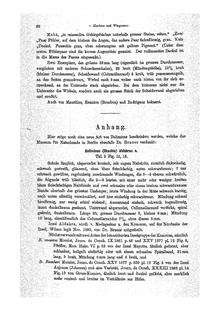Aldabra banded snail
The Aldabra banded snail (Rhachistia aldabrae) is a species of air-breathing land snail, a pulmonate gastropod mollusc in the family Cerastidae. The species lives on one atoll in the Seychelles Islands, Indian Ocean, and is easily recognizable for its purplish-blue banded shell. The species was thought to have died out because of climate change,[3] but was rediscovered in 2014.

| Aldabra banded snail | |
|---|---|
 | |
| Drawing of the shell of Rhachistia aldabrae | |
| Scientific classification | |
| Kingdom: | |
| Phylum: | |
| Class: | |
| (unranked): | clade Heterobranchia
clade Euthyneura clade Panpulmonata clade Eupulmonata clade Stylommatophora informal group Orthurethra |
| Superfamily: | |
| Family: | |
| Genus: | |
| Species: | R. aldabrae |
| Binomial name | |
| Rhachistia aldabrae (von Martens, 1898)[2] | |
| Synonyms | |
| |
Description
The shell of this snail is very unusual in its coloring: purple, indigo blue, and orange, and this makes the snail very easy to recognize and identify. The Aldabra snail grazes on algae, and thus it is very low on the food chain.[4]
The shell of this species is oblong, ovate-conical, rather thick, slightly striated, glossy, in the upper part is pale, in the lower part it is black brown.[2] The shell has seven slightly curved and regularly increasing whorls.[2] The upper 3-4 whorls are blackish, the following are dim bluish.[2]
Distribution
The Aldabra banded snail is endemic to Aldabra Atoll in the Indian Ocean. In 1906 it was the most common snail species on the atoll.[5][6]
After 1976 however, only adult snails were found on Aldabra, and no live individuals had been found at all between 1997 and August 2014.[3] Researchers had believed that this species became extinct during the late 1990s, after a series of unusually long, hot, and dry summers caused by climate change. These summers appear to have killed off a large number of the younger snails.[7]
Cause of apparent extinction
The habitat of this snail suffered a sudden decline in rainfall in the 1990s, which was essential to the survival of this species, and this dryness appeared to have caused its extinction. Living snails were discovered on 23 August 2014.[8][9][10][11]
Rediscovery
A number of specimens of the snail were discovered on August 23, 2014. A team of Seychelles Islands Foundation (SIF) staff were exploring infrequently visited parts of Malabar Island, the second largest island of Aldabra, when the snails were found. Dr Frauke Fleischer-Dogley, CEO of the CIF, commented:[8][12]
The re-discovery of the Aldabra banded snail provides a beacon of hope. Despite major global environmental threats like climate change, this discovery shows that investments into protecting unique island biodiversity are well-placed. This snail provides hope for other island species, of which we have already lost too many. I hope that those of the international community, who are meeting at the Third International Conference on Small Island Developing States, take note that their investment is needed to generate such success. Nature has a resilience that may surprise us.
References
This article incorporates public domain text from the reference.[2]
- Gerlach, J. 2018. Rhachistia aldabrae. The IUCN Red List of Threatened Species 2018: e.T168122A67485998. https://dx.doi.org/10.2305/IUCN.UK.2018-1.RLTS.T168122A67485998.en. Downloaded on 28 December 2018.
-

- Gerlach, J. (2007). "Short-term climate change and the extinction of the snail Rhachistia aldabrae (Gastropoda: Pulmonata)". Biology Letters. 3 (5): 581–584. doi:10.1098/rsbl.2007.0316. PMC 2391199. PMID 17666376.
- Butler, Rhett A. (August 13, 2007). "Climate change claims a snail". mongabay.com. Archived from the original on July 13, 2012.
- Smith M. (October 1909) "The land Mollusca on Aldabra". The Nautilus 23(5): 69-70.
- van Brugge A. C. (17 September 1975) "Streptaxidae from Aldabra Island, Western Indian Ocean". Bulletin of the British Museum (Natural History), 28(5): 157-175. page 171.
- Jacquot, Jeremy Elton (August 9, 2007). "Is the Aldabra Banded Snail the First Global Warming Related Extinction?". treehugger.com. Retrieved 17 November 2014.
- "Extinct snail re-discovered at Aldabra Atoll".
- Amla, Hajira (August 30, 2014). "Living to fight another day – 'extinct' Aldabra snail re-discovered in Seychelles". Seychelles News Agency. Retrieved 8 September 2014.
- "Seychelles snail, thought extinct due to climate change, still alive". The Detroit News. Associated Press. September 8, 2014. Retrieved 17 November 2014.
- Battarbee, Richard W. (15 October 2014). "The rediscovery of the Aldabra banded snail, Rhachistia aldabrae". Biol. Lett. 10 (10): 20140771. doi:10.1098/rsbl.2014.0771. PMC 4272217. PMID 25319822.
- Amla, Amla (30 August 2014). "Living to fight another day – "extinct" Aldabra snail re-discovered in Seychelles". Seychelles News Agency. Retrieved 3 October 2017.
External links
- Photos of shells of this species (Note: there are spelling errors on the page.)
